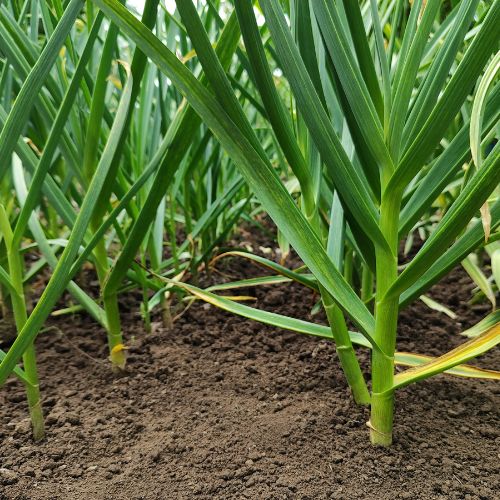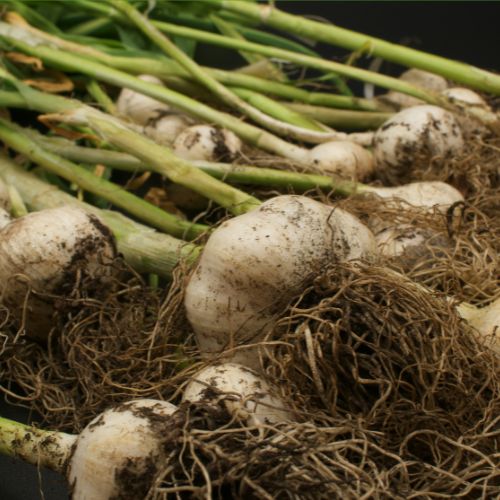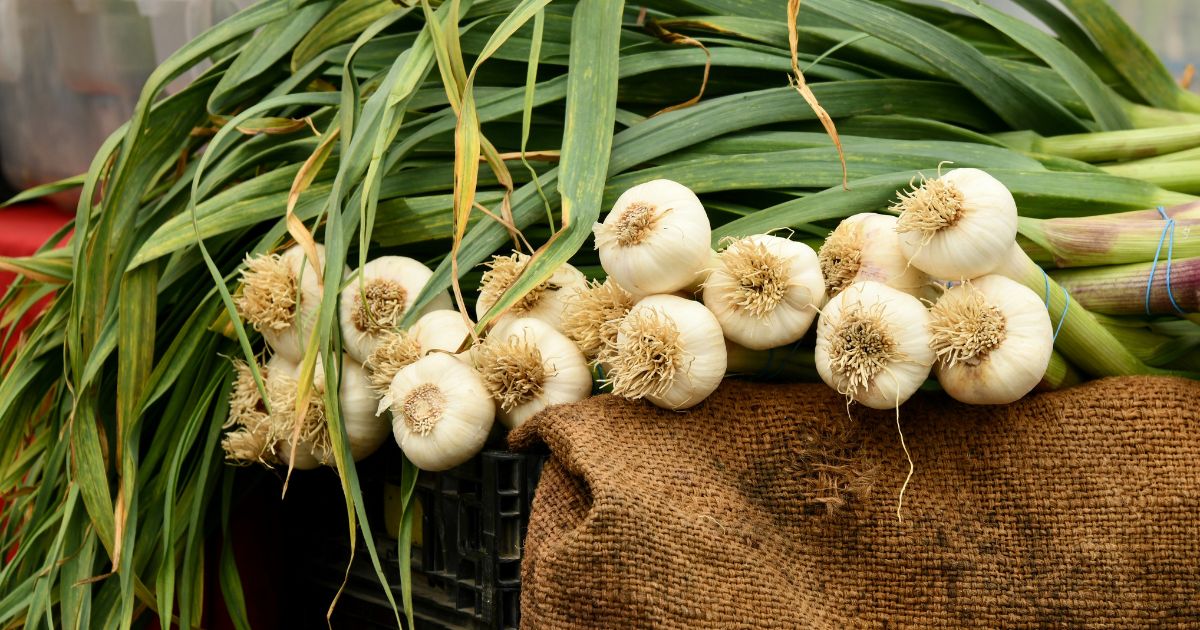In This Article
Introduction
There’s something magical about harvesting your own garlic—pulling up a bulb and knowing you nurtured it from a tiny clove into a pantry essential. But timing matters. If you’ve ever wondered when do you pick garlic and felt unsure, you’re not alone. Picking it too soon risks losing flavor, while waiting too long can ruin your hard work. In this guide, I’ll help you unlock the secrets to harvesting garlic at the perfect moment, ensuring your crop is as satisfying as it is flavorful. Let’s dig in!
How Garlic Grows: Key Stages to Know
Understanding garlic’s growth stages is essential to answering the question: when do you pick garlic? Garlic grows in a predictable cycle, making it easier to know the right time for harvesting.
Garlic is typically planted in the fall, allowing its roots to establish before winter. During early spring, green shoots emerge as the plant begins to grow rapidly. By late spring to early summer, the energy shifts to bulb development beneath the soil.
The key to determining when to pick garlic lies in observing its leaves. As garlic matures, its leaves start to dry out and turn yellow or brown, starting from the bottom of the plant upward. A good rule of thumb is to wait until three to four of the lower leaves have browned, while the upper leaves remain green. This balance indicates that the bulbs are full-sized and haven’t begun to split.
Mistiming your harvest can impact garlic quality. Pulling it too early results in small, underdeveloped bulbs, while waiting too long risks splitting or rot. Paying attention to these stages ensures flavorful, long-lasting garlic.
By closely watching your plants, you’ll know exactly when do you pick garlic for the best results.
When Do You Pick Garlic? Key Indicators
Knowing when do you pick garlic is critical for achieving the best flavor, size, and storage life. Garlic doesn’t provide an obvious signal like ripe tomatoes or squash. Instead, you’ll need to rely on subtle yet reliable indicators.
The most telling sign is the condition of the leaves. As garlic matures, the lower leaves start to turn yellow or brown while the upper leaves remain green. The ideal time to harvest is when about 3–4 leaves have browned, leaving the rest of the plant healthy and green. This means the bulbs are fully formed and ready to cure.
Timing is everything. Harvesting too early results in small, soft bulbs that won’t store well. On the other hand, waiting too long can cause the outer layers to rot or the bulbs to split open, reducing their quality and shelf life.
Another method is to gently dig around a bulb and check its size. A mature garlic bulb will feel firm, with tightly packed cloves covered in a papery skin. Avoid pulling the plant without loosening the soil first—this can damage the bulb.
Mistakes in timing often happen due to impatience or uncertainty. To ensure a perfect harvest, monitor your plants carefully as the season progresses. Keep in mind that the exact timing depends on the variety of garlic and your local climate, but observing these indicators will guide you confidently.
By paying attention to these signs, you’ll know exactly when do you pick garlic for a successful harvest.
How to Harvest Garlic the Right Way
Once you’ve identified when do you pick garlic, the next step is to harvest it correctly to avoid damaging the bulbs. Harvesting garlic isn’t complicated, but following a careful process ensures the best results.
Tools You’ll Need
Before you start, gather the right tools:
- A garden fork or trowel to loosen the soil.
- Gloves to protect your hands.
- A soft brush or cloth for cleaning the bulbs.
Step-by-Step Harvesting Guide



- Loosen the Soil Around the Bulbs
Use a garden fork or trowel to loosen the soil several inches away from the base of the garlic plant. Be gentle to avoid piercing the bulbs. - Gently Lift the Garlic
Grip the stalk near the base and carefully pull the bulb out of the loosened soil. Avoid yanking the plant, as this can cause the stalk to break, making it harder to handle and cure. - Inspect the Bulbs
Check each bulb for size and firmness. A properly matured bulb will have tightly packed cloves with a thin, papery skin. - Clean the Garlic
Remove loose soil by brushing it off gently. Avoid washing garlic, as excess moisture can lead to mold during the curing process.
Common Mistakes to Avoid
- Pulling Too Early: Immature bulbs are small and soft.
- Waiting Too Long: Overripe bulbs can split or rot.
- Rough Handling: Damaged bulbs are more prone to spoilage.
By following these steps, you’ll preserve the quality of your garlic and set the stage for proper curing and storage. Understanding when do you pick garlic is only part of the equation—harvesting with care ensures your hard work pays off with a flavorful and long-lasting crop.
Caring for Your Garlic After Harvest
Harvesting your garlic is just the first step. Proper post-harvest care ensures your bulbs stay flavorful, firm, and long-lasting. Once you’ve figured out when do you pick garlic, focus on cleaning, curing, and storing it the right way.
Cleaning Garlic Without Washing
Freshly harvested garlic is often covered in soil, but it’s important not to wash it. Excess moisture can lead to mold and shorten the shelf life. Instead:
- Gently brush off the loose dirt with your hands or a soft brush.
- Leave the outer papery layer intact to protect the cloves during curing.
- Trim the roots slightly, but avoid cutting too close to the bulb.
Curing Garlic for Long-Lasting Flavor
Curing is essential to enhance garlic’s flavor and storage potential. Here’s how:
- Tie garlic in small bundles or spread it out in a single layer on a mesh rack.
- Hang or place it in a warm, dry, well-ventilated space out of direct sunlight.
- Allow 2–3 weeks for curing. During this time, the outer layers will dry and harden, forming a protective skin.
Storing Garlic Properly
Once cured, trim the stalks to about an inch above the bulb. Store garlic in a cool, dry place with good air circulation, such as a pantry or mesh bag. Avoid airtight containers, as they trap moisture and cause spoilage. When stored properly, garlic can last up to 6–12 months.
By following these steps, you can enjoy the rewards of your harvest for months to come. Remember, when do you pick garlic is just as important as how you handle it afterward—proper care ensures maximum flavor and longevity.
Common Questions About When to Pick Garlic
Q: When do you pick garlic during the year?
Garlic is typically ready for harvest in late June to early July, depending on your region and the variety planted. Monitor the plant closely for signs of maturity, like browning leaves.
Q: Can I eat garlic immediately after harvesting?
Yes, freshly picked garlic is edible, but curing it for 2–3 weeks enhances its flavor and improves its storage life.
Q: What happens if I pick garlic too early?
Harvesting garlic too soon results in small, soft bulbs that lack full flavor and won’t store well.
Q: What if I wait too long to harvest garlic?
Overripe bulbs may split or rot, reducing their quality and shelf life.
By addressing these common concerns, you can confidently determine when do you pick garlic and enjoy a successful harvest every season.
What Can You Plant After Garlic in November?
Once you’ve figured out when do you pick garlic and harvested your crop, it’s time to plan your next planting. November is ideal for planting cool-season crops or cover crops that restore soil health.
Vegetables to Plant After Garlic
- Leafy Greens: Spinach, kale, and lettuce thrive in the cool temperatures of late fall.
- Root Vegetables: Carrots, radishes, and beets grow well in the space left by garlic.
Cover Crops for Soil Health
Planting cover crops like clover or rye can replenish nutrients that garlic depletes, especially nitrogen. These crops also prevent soil erosion and improve structure during the winter months.
Crop Rotation Tips
Avoid planting other alliums, like onions or leeks, in the same spot immediately. Crop rotation helps minimize the risk of pests and diseases.
By planning ahead, you’ll keep your garden productive and healthy after learning when do you pick garlic.
Planning Ahead for a Better Garlic Harvest
Now that you’ve mastered when do you pick garlic, it’s time to think about next year’s harvest. Proper planning and preparation can lead to bigger, healthier bulbs and a more rewarding gardening experience.
Choosing the Right Garlic Varieties
Select varieties that suit your climate.
- Hardneck Garlic: Thrives in colder regions, producing robust flavors.
- Softneck Garlic: Best for warmer areas, stores longer, and is easier to braid.
Preparing the Soil
Garlic grows best in loose, well-draining soil enriched with organic matter.
- Add compost or aged manure before planting to boost nutrients.
- Test soil pH—it should be between 6.0 and 7.5 for optimal growth.
Planting Tips
Plant garlic in the fall, about 4–6 weeks before the ground freezes. Space cloves 4–6 inches apart, with the pointed side up. Mulch the bed to protect against cold weather and suppress weeds.
By taking these steps, you’ll set the stage for a successful crop. Remember, knowing when do you pick garlic is just one piece of the puzzle—consistent care and thoughtful planning ensure the best results season after season.
Conclusion
Harvesting garlic doesn’t have to be a guessing game. By understanding when do you pick garlic and following these simple steps, you’ll enjoy flavorful, long-lasting bulbs that reward your efforts. Whether you’re a seasoned gardener or just starting out, learning the right timing and techniques can transform your gardening journey.
If you found this guide helpful, subscribe to my newsletter for more gardening tips, seasonal planting advice, and expert insights. Let’s grow something amazing together!

